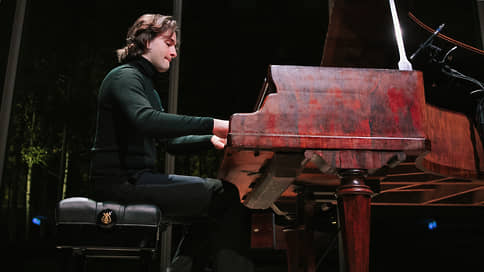Each piano has its own time – Newspaper Kommersant No. 207 (7408) of 09.11.
[ad_1]

The House of Culture GES-2 hosts the Rachmaninoff Fest, dedicated to Sergei Rachmaninov and romantic music, old pianos and contemporary Russian pianism. The festival, where Miroslav Kultyshev, Arseniy Tarasevich-Nikolaev and Yuri Favorin have already performed, will end in December with a concert by Alexei Lyubimov, a connoisseur of historical performance. About the experiences of turning textbook scores into contemporary art by the hands of musicians who first touched archival instruments, tells Yulia Bederova.
A symbol of the Russian pianistic tradition, if not of the “Russian soul” itself, Rachmaninov knew a lot about the modernization of space: he did agricultural and landscape work twice – on his estate Ivanovka, which was forced to be abandoned during the revolution, and in the Swiss villa Senard, abandoned at the beginning of World War II. war. Perhaps he would have approved the artificial neatness of the birch plantations behind the glass of the GES-2 hall, acting as a backdrop, indulged in nostalgia, or, on the contrary, criticized their even order. Be that as it may, it was the art of the main Russian pianist and émigré composer, whose 150th birthday will be in 2023, that became the starting point for the concert series at GES-2 with the participation of pianists-stars of the new generation (their list could be longer if would not have left Russia for several key figures), but did not become the basis of the repertoire: the tone was set by Schumann and Chopin.
Also, as they say, at the entrance it was decided to erode the museum-fraque spirit from the clavirabend genre by arranging an experiment with an unobvious result. Instead of modern concert instruments with their almost universal sound characteristics, there were grand pianos alien in the academic context of the 19th and early 20th centuries: the lacy Bluethner of 1868 (from the collection of Alexei Lyubimov) – for Chopin and Brahms, pathetically painted in reddish tones by Erard of 1848 – for Chopin and Schumann. And finally, for the music of Schumann, Feinberg and Rachmaninoff – the gloomy black C. Bechstein of 1936, which has seen the views of pre-war Berlin and those that opened after the war until the very 1990s from the windows of the apartment in the House on the Embankment, where he was until his rescue Museum-workshop of Alexei Stavitsky.
The retromechanics of historical performance with its basic rule “we play music on instruments of the time of its creation” was taken as a model, but absolutely exact historical correspondences were not and could not be discussed – the choice of such instruments in Moscow is still not rich. Therefore, an attempt to modernize the space of interpretation through a rather conventional “historicism” looked risky in advance. But the risk of loss of quality or confusion of styles turned out to be justified – in fact, I had to play on the boundary between history and modernity, constantly eluding unambiguous definitions, on the gaps between the time when music was written and its entry into the canon, the time when the instrument was created and today’s time. So the usual notes and contexts really began to sound unrecognizable. If Chopin and Brahms in Miroslav Kultyshev’s post-Chopin’s Blutner were significant, but still too careful to grow with discoveries, then the rare “Shards” of 1917 played as an encore (the last Rachmaninov’s phrases written in Russia) with their fragmented cantilena set the festival plot important semantic direction.
On the second evening, Arseniy Tarasevich-Nikolaev nurtured for Chopin at Erar some completely unheard of, crystal, ghostly harpsichord colors, flying pedals and dry, finely dispersed shine. And at the same time, he passionately mixed the contradictions between Chopin’s confessionalism and extravagance, the discipline of form and its unpredictability, nostalgia for an enslaved homeland and Parisian temptations. Schumann’s Butterflies, Grieg’s miniatures, and a little more Rachmaninov (Fantasy Pieces, Op. 3), an early but still critically beyond the capabilities of the instrument of 1848, suggested: listening to the response of the old instrument, to the way it requires unprogrammed articulation, dynamics, phrases, sound connections, the performer, and after him the listener, find themselves right in the face of a simple, in essence, aesthetic conflict. It is clear that the old piano imposes serious restrictions on modern experience – a literal transfer of manners and ideas is impossible. But it is clear that a standardized modern tool also has its own limitations. Sometimes it is still not enough for the space of the score to remain ambivalent, open to new interpretation. At times it seemed, for example, that it was the old piano that made it possible to wash away the sticky dust of the school concept of “homesickness” from the music of Chopin and Rachmaninoff as a tool for legalizing complex authors in the status of simple textbook quantities. That it also helps to rehear the dramatically fragile imaginary landscape of the Second and Third ballads and Chopin’s Scherzo No. 3 by Tarasevich-Nikolaev, the underground Scriabinianism of the Soviet professor Samuil Feinberg, or the symbolist forest of the first edition of Rachmaninov’s Second Sonata in Favorin’s unique interpretation, very terrible in its disappointment. Of course, the sound, material, structural problematization of the romantic and post-romantic repertoire (as in Favorin, who studied Bechstein of 1936 as if to the very bottom of the keyboard memory) makes it not only aesthetically, but also ethically sharpened, makes it possible to hear both time and timelessness. But, fortunately, it still does not answer the questions “where are we” (losing their homeland and remaining), “who are we” (looking for historical correspondences and getting confused in facts and objects), what kind of “Cursed place” from “Forest Scenes” Schumann, where Favorin leads the listeners, and what we are forced to say goodbye to with Schumann’s Farewell. Otherwise, the answers would be unnecessarily straightforward.
[ad_2]
Source link






